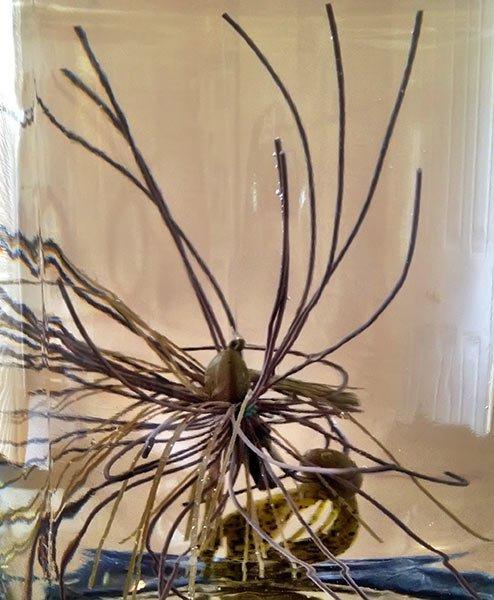Warning: Undefined variable $k in /home/nginx/domains/wired2fishcom.bigscoots-staging.com/public/wp-content/themes/understrap-child-0.6.0/functions.php on line 984
Warning: Undefined variable $k in /home/nginx/domains/wired2fishcom.bigscoots-staging.com/public/wp-content/themes/understrap-child-0.6.0/functions.php on line 987
I have a problem—a very serious one, at that. I am addicted to flipping a jig. While one could certainly have much worse problems in life, I will flip a jig in just about any possible situation. I believe that learning how to flip a jig is the single, most effective way to improve the quality of your fish catches.
I was first introduced to the Buckeye Mop Jig in March of 2009, and what an incredible day that was. After seeing it for the first time, I thought that there was no possible way a bass would eat such a big, ugly bait. I couldn’t have been more wrong.
We put the boat in the water shortly after lunch, and before dinner our biggest five bass weighed more than 29 pounds—every single fish coming on the 3/8-ounce black/blue Mop Jig. For the next three consecutive days, our smallest limit was 21 pounds. Needless to say, from that day forward, I have been a Buckeye Mop Jig believer.
The first thing you will realize upon inspection of the Mop Jig is its massive size. With its hand-tied, heavy living-rubber skirt extending almost 5 inches from the hook tie, it will easily cover the entire palm of a grown man’s hand. Furthermore, the real shock comes when you first see this jig in the water. Expanding to roughly the size of a softball when submerged, the profile and slow fall of the Mop Jig attracts some of the biggest, meanest bass in the lake.

While it may be tempting to trim the larger-than-normal skirt in an attempt to better expose your trailer, the living rubber skirt makes that unnecessary. When a Mop Jig sits on the bottom, its unique head style allows it to stand up— and when the skirt flares outwards in order to emulate a crawfish’s defensive posture, the trailer is actually better-exposed than many other jigs. I do, however, like to trim my Mop Jigs when fishing for spotted bass and smallmouth. Doing so helps eliminate a lot of short strikes and “pecks” from these fish.
The large skirt is not only made to “look big,” but also, as the jig sits on the bottom with the skirt expanded, even the smallest motions of the rod cause small vibrations in the living rubber, therefore providing added water displacement for big bass to key in on with their lateral lines. I’ve caught numerous Mop Jig fish by firmly squeezing the handle of my flipping stick, sending that very small vibration to the jig which triggered the strike. When it comes to jigs, it can’t get much cooler or more detail-oriented than that.
Another impressive aspect of the Mop Jig is its double rattles located at the top of the hook shank. A lot of other jigs I’ve used have very loud, unnatural rattles. The Mop Jig’s rattles mimic the movement and clicking of fleeing crawfish in an extremely realistic manner, while not being too loud or overzealous. Fastened tightly to the jig, the rattles aren’t going to fly off when you cast the Mop Jig or when you accidentally knock it against a dock. Although they’re firmly attached to the hook, I have actually had bass knock the rattles off of these jigs—not due to any lack of quality, but because big bass absolutely crush these things.
Buckeye Mop Jigs also sport a big, razor-sharp Mustad Flippin’ Hook that allows for hard hooksets and supreme confidence, leaving little room for short strikes. When you get a Mop Jig bite, you can bet the farm that you’ll get the fish into the boat. While the hooks are sharp, you will need to sharpen them occasionally, as fishing jigs in heavy cover does tend to dull hooks quickly.
The Mop Jig can be used for all types of applications—some of my favorite are flipping, swimming and casting. With four convenient sizes to choose from, ranging from 1/4 ounce to 5/8 ounce, there is a Mop Jig for just about every situation, even given the limited color options. The unique head style makes it easy to flip around cover and under docks, while also giving the jig a unique ability to swim well and cast effectively. While these jigs can be hugely effective in deep brush piles, long casts should be avoided as the Mop Jig will occasionally become snagged on deeper cover.
If you’re looking for a way to increase the quality of the bass you catch, don’t hesitate to give the Buckeye Mop Jig a chance. Although a little pricey at $4.59 per jig, the high cost has the potential to pay huge dividends on the water. From farm pond anglers to serious tournament fishermen, this jig will catch bigger fish.
To see more about this bait or order, visit Tacklewarehouse.com.












